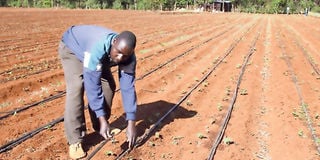Agronomist notebook: Getting drip irrigation right

A man checks on set drip irrigation pipes in a farm in Uasin Gishu in this past photo. When buying drip lines, consider quality, durability and the flow rate of water. FILE PHOTO | NMG
What you need to know:
- Drip is the commonly used irrigation system in Kenya, with the others being overhead and surface irrigation.
- The choice of an irrigation method depends on the topography of the land, availability of water, variations in soil types, source of power to pump water, on-farm storage capacity and capital required.
- The visible appearance of crops such as leaf colour, curling of leaves and the ultimate wilting, also acts as a guide to determine the amount of water required by the plant.
- Overwatering often leads to wastage, rise in pests and diseases such as damping off, which increase a farmer’s cost of production.
It is now common knowledge that rain-fed farming is no longer viable.
Most farmers are, therefore, going for irrigation systems to give their crops sufficient water as the dry spell bites.
But even as many take up the technology, few farmers know how to efficiently use the various irrigation systems for more yields.
I visited farmer Mary the other day in Machakos when she had just harvested her bulb onions. She proudly informed me that she harvested about seven tonnes per acre.
Well, I could share her joy but the harvest was quite below the expected yields of 16-20 tonnes per acre.
One of the things to which I attributed the low yields was the irrigation scheduling, which Mary said she had a problem with. According to her, she watered her crops every day using the drip irrigation systems for about 20 minutes.
The recommended watering duration using the drip irrigation system for her area is two hours, three times per week, but it depends on the weather conditions.
Drip is the commonly used irrigation system in Kenya, with the others being overhead and surface irrigation. The choice of an irrigation method depends on the topography of the land, availability of water, variations in soil types, source of power to pump water, on-farm storage capacity and capital required.
The irrigation system layout is critical on a farm set-up since the design and performance should be in line with irrigation scheduling to enhance the farmer’s skills to control and manage the system more efficiently.
Ideally, it’s important to water early in the morning or late in the evening as this helps the plants to absorb water. Watering when the temperatures are too high results in water loss due to evaporation.
Before watering, the farmer should do a simple water test by feeling and observing the appearance of the soil and the crops.
GROWING STAGE OF THE CROP
This is done by squeezing soil into a ball and creating a ribbon between the thumb and the fore fingers.
Sticky means that it is well watered while loose soil shows one should irrigate the crops.
The visible appearance of crops such as leaf colour, curling of leaves and the ultimate wilting, also acts as a guide to determine the amount of water required by the plant.
The number of times to do the watering a week also depends on the growing stage of the crop. For instance, during the early stages of growth and when forming bulbs, onions require adequate water, unlike at harvesting time when they require curing.
Overwatering often leads to wastage, rise in pests and diseases such as damping off, which increase a farmer’s cost of production.
When buying drip lines, consider quality, durability and the flow rate of the water. One should also ensure that the drip lines used are from reliable supplies.
Blocked emitters can be cleaned by flushing the drip lines, gently knocking the emitters while water is running or fertigate using phosphoric acid to clean the emitters.
The length of the drip line must also be considered when laying out the lines. Some farmers have more than 70 metres long lines that make water distribution a challenge since the pressure is not enough. A good drip line length should be 36-50 metres, depending with the water pressure.
Once in a while, test water flow rates in the drip lines by placing a beaker on the lower side of the emitter while timing to determine the amount of water it supplies to the crops.
The land should also be gently sloping to allow proper water distribution to all crops.
The cost of pumping water from a source or reservoir to tanks using electricity is high, therefore, farmers should invest in solar panel, which is cheap and environmental friendly.
All said, ensure the water used for irrigation is safe for use and free off contamination. If possible, test its chemical composition.





